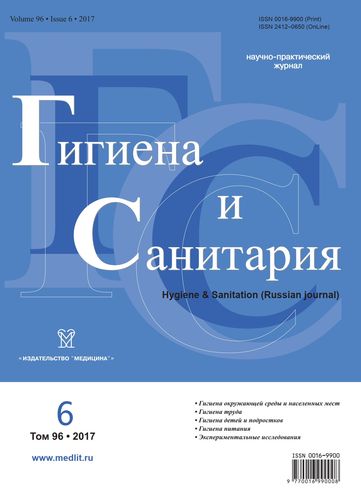The influence of occupational factors on indices of red blood of donors of the industrial city
- Authors: Elifanov A.V.1, Solovyev V.S.1, Lepunova O.N.1, Frolova O.V.1, Kovyazina O.L.1
-
Affiliations:
- Tyumen state University
- Issue: Vol 96, No 6 (2017)
- Pages: 548-551
- Section: OCCUPATIONAL HYGIENE
- Published: 21.10.2020
- URL: https://ruspoj.com/0016-9900/article/view/640781
- DOI: https://doi.org/10.47470/0016-9900-2017-96-6-548-551
- ID: 640781
Cite item
Full Text
Abstract
The problem of blood transfusion is closely associated with a reduction in the number of donors — people donating blood voluntarily, which is especially important for the modern industrial city. There was executed the study of the movement of the donation at the enterprises with harmful working conditions in the city of Tyumen. These enterprises with a large number of workers have the stable gain in persons willing to donate blood, but in parallel, there is increasing the number of persons receiving the allotment. In the work there was investigated an influence of occupational factors on indices (hemoglobin concentration, number of red blood cells, ESR, hematocrit, color index ) of the red blood of donors, with taking into account their gender and age. Results of the survey of 4 267 blood donors in 2011-2014 show an increase in the number of medical counterindications for donations, due to changes in red blood indices in persons, working at enterprises with harmful working conditions. In all examined men and women whose work is associated with harmful occupational factors, there was revealed a significant decline in hemoglobin concentration and erythrocyte count. Objective hematologic observations along with subjective assessments of donors of their own health have shown the development of anemic syndrome — one of the main syndromes of lead professional pathology. It is necessary to continue the search for factors contributing to the increase in the share of the withdrawal of donors due to low hemoglobin concentration. It is recommended the supplement of industry reporting with stratified rates of the withdrawal of donors before donation and the development of an algorithm for the rehabilitation of exempted donors. Among the most promising measures for the maintenance and development of the donation at enterprises with harmful working conditions, specific plans for improving health including specific means and conditions for the recovery of the blood system should be developed.
About the authors
Andrey V. Elifanov
Tyumen state University
Author for correspondence.
Email: andelwas@mail.ru
MD, PhD, associate professor, a professor of the Department of Anatomy and Human and Animal Physiology of the Institute of Biology of the Tyumen State University, Tyumen, 625000, Russian Federation.
e-mail: andelwas@mail.ru
Russian FederationV. S. Solovyev
Tyumen state University
Email: noemail@neicon.ru
Russian Federation
O. N. Lepunova
Tyumen state University
Email: noemail@neicon.ru
Russian Federation
O. V. Frolova
Tyumen state University
Email: noemail@neicon.ru
Russian Federation
O. L. Kovyazina
Tyumen state University
Email: noemail@neicon.ru
Russian Federation
References
- Fedorov N.A. Normal Hematopoiesis and its Regulation [Normal’noe krovetvorenie i ego regulyatsiya]. Moscow: Meditsina; 1976. (in Russian)
- Grishina O.E. Formation and management of donor contingent on the model of departmental services of the blood: Diss. Moscow; 2008. (in Russian)
- Zhiburt E.B. Standards in Blood Transfusion Services [Standarty kachestva v sluzhbe krovi]. Moscow: NPTs Intelforum; 2005. (in Russian)
- Kopchenko T.G., Gubanov M. N., Kayumova L.I., Zhiburt E.B. Seasonal changes in the share of withdrawal of donors with low concentration of hemoglobin. Vestnik sluzhby krovi Rossii. 2009; 2 (1): 8–11. (in Russian)
- Kodenev A.T., Gubanova M.N., Zhiburt E.B. Annual rhythm of low hemoglobin concentration among potential donors of the South of Russia. Vestnik sluzhby krovi Rossii. 2009; 4 (1): 26–9. (in Russian)
- Order of the Ministry of Health of the Russian Federation No. 364 “On approval of the order of medical control of blood donors and its components”. Moscow; 2001. (in Russian)
- Frol’kis V.V., Bezrukov V.V. Circulation and Aging [Krovoobrashchenie i starenie]. Leningrad: Nauka; 1984. (in Russian)
- Kosarev V.V., Babakov S.A. Professional Diseases [Professional’nye bolezni]. Moscow: Bikom; 2011. (in Russian)
- Panchenkov T.P. Determination of blood sedimentation by using the capillary. Vrachebnoe delo. 1924; 16 (1): 695–7. (in Russian)
- Volkova S.A., Mayanskiy N.A., Borovkov N.N., Balabanov A.S., Egorova T.V., Podsosova E.V. et al. Indicators of haemogram in the adult working population. Gematologiya i transfuziologiya. 2008; 53 (1): 21–7. (in Russian)
- Kozinets G.I., Kalomova D.R., Pogorelov V.M. Cells of peripheral blood and environmental factors in the external environment. Kliniko-laboratornaya diagnostika. 1993; 1 (1): 14–20. (in Russian)
- Men’shikov V.V. Laboratory Methods in the Clinic: Handbook [Laboratornye metody issledovaniya v klinike: Spravochnik]. Moscow: Meditsina, 1987. (in Russian)
- Shiffman F. D. Pathophysiology of Blood [Patofiziologiya krovi]. Moscow: Binom; 2007. (in Russian)
- Solov’eva S.V., Solov’ev V.S., Elifanov A.V., Panin S.V. Physiology and Pathology of Circulation and Respiration in Humans in the North [Fiziologiya i patologiya krovoobrashcheniya i dykhaniya u cheloveka na Severe]. Tyumen’: TyumGU; 2008. (in Russian)
- Hoekstra T., Veldhuizen I., van Noord P.A., de Kort W.L. Seasonal influences on hemoglobin levels and deferral rates in whole-blood and plasma donors. Transfusion. 2007; 47 (5): 895–900.
- Hu M., Finni T., Sedliak M., Zhou W., Alen M., Cheng S. Seasonal variation of red blood cell variables in physically inactive men: effects of strength training. Int. J. Sports Med. 2008; 29 (7): 564–8.
- Lau P., Hansen M., Sererat M. Influence of climate on donor deferrals. Transfusion. 1988; 28 (6): 559–62.
Supplementary files









